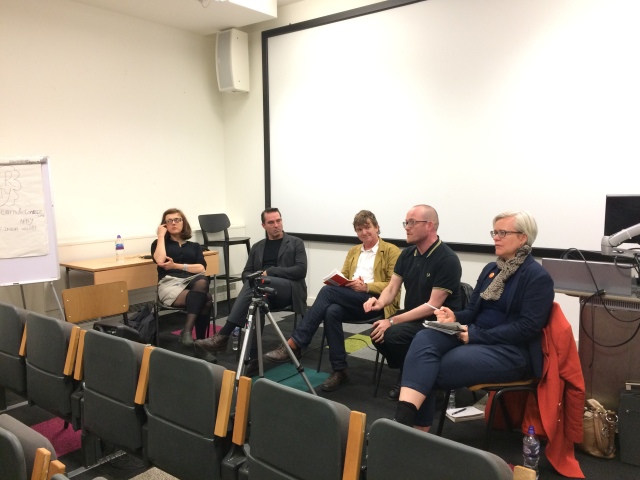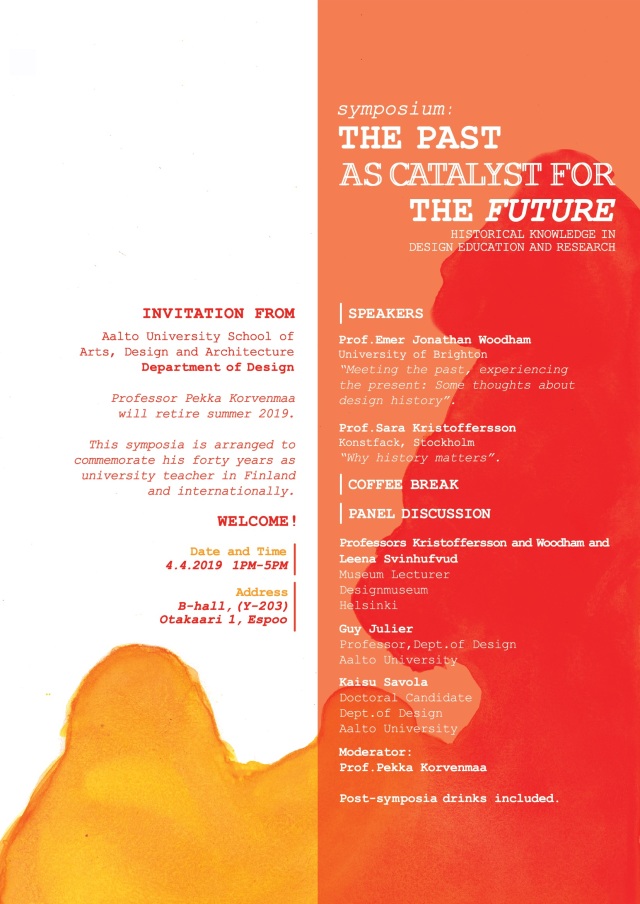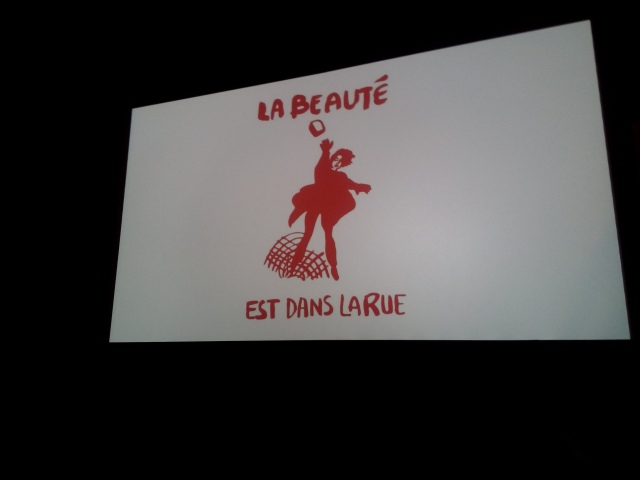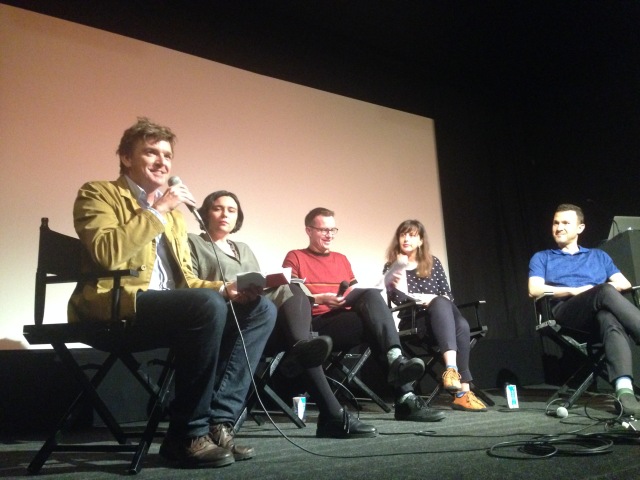This Salon came during the heady and feverish season of art and design degree shows in the UK. Once the display boards are dismantled, the degree results promulgated and we’ve swept up, there is often a feeling of summer ennui.
Was the degree show worth it? What are these graduates going to do out in the post-University world? What have we learnt?
And then the summer holidays pass, we relax a bit (perhaps) and then we get back to business as normal for the new academic year.
At the end of this Salon, our chair, Lucy Kimbell asked, ‘Have we reached peak design school?’

l. to r.: Joahanna Boenhert, Cameron Tonkinwise, Guy Julier, Jamie Brassett, Lucy Kimbell (photo: Naomi Bailey-Cooper)
All the panelists (including this one) agreed that we had – all for different reasons. Call us jaded if you like, but there was a unanimous feeling that there has been enough ‘training’ or ‘education’ of designers for a particular worldview (a predominantly neoliberal one) and that the only way to break this relentless cycle of disciplining individuals to be creative (in a very particular way) is to stop design schooling. Perhaps this could be basis of a new De.School…?
Certainly, with around three times more design graduates each year than there are design jobs for them, it has been time to reconsider what design schools are there for a long while. That’s if we are to view design schools in their current dominant state: as worker-mills that churn out neoliberal-compliant, ‘industry-ready’ individuals to fill out the precariat of interships or the barely-paid short-term contracts that make up the junior labour force of the creative industries.
But, perhaps, if we see the role of design schools to decouple design research, education and practice from the multiple vectors of neoliberalism then we can pull them back from this brink and rethink them. For me, and drawing a bit on the reflections of other panelists, Johanna Boehnert, Jamie Brassett and Cameron Tonkinwise, this requires a reframing of the output of design schools. By this, I don’t just mean the skills and knowledge that graduates leave with but also the way by which they are presented.
While degree shows provide a nice opportunity to celebrate material output, see old friends and have a glass of warm white wine, they largely reproduce the performative spectacle of design as told through the reified object. Of course, I’m not the first to say this, and, indeed, these Design Culture Salons are, in part, a way of coming at design in a different way from this, to open up its fissures and discourses.
So how do we align the important work of design in exploring and extending material realities in ways that confront, adjust and/or articulate the multiple crises (of capital, of environment, of equality, of representation, of identity etc.) that we are facing?
Before I answer this, let me add in a rejoinder. This is that we should be talking about design schools rather than the design school. We should resist all those totalising notions of design and the design school (which, by default, means ‘design in service mode to neoliberalism’). If I sound like a broken record then fine, but there are many models for design schools that provide starting points: craft-based, business-oriented, user-centred, individual-focused, teamwork-developing, engineering-driven, sustainability-grounded and so on. The difficulty, though, is that they still currently come under a singular rubric of employment culture and politics. They are still pretty much about training for a very specific set of economic and political circumstances.
In recent years, we have seen increased spillage of design research and practice into other knowledge domains through approaches such as design thinking, social design, design anthropology, strategic design, design for policy, transition design, design culture as practice and several other specialisms. Design education has lagged behind these, though.
However, would it not be compelling to stop worrying about these in the design school, but to site design education outside its traditional settings? In social science departments, medical schools, healthcare settings, or community centres, for example? Can these be the kinds of places where design education can get reframed in powerful, informed and challenging ways?
Anyone who has visited the former Bauhaus school in Dessau will be struck by their majestic, utopian environment. This utopianism — of the hermetically sealed, creative environment — lingers on in most design schools.
Half a century ago, design students and tutors were talking about throwing bricks through the Bauhaus windows, but this was just the beginnings of a stylistic break with Modernism. Generally, they have been peering outward through these broken windows ever since. Few have climbed out of them to establish themselves elsewhere, though.
Such moves might not entirely remove design and design schools from the neoliberal order. I’m not sure if neoliberalism can ever be fully eradicated (pace Simon Springer). But we still have to come back to the original proposition of this Salon and talk about this connection and how it can be redirected. The first step is to reveal and explain the deep links between the two. The next step might be to explore how design can function, along with other fields, in new and different ways.

Photo: Naomi Bailey-Cooper
In a blog that followed the Salon, Johanna Boehnert neatly summed up what she was thinking – and probably all of us. Read the whole blog with attention, but here is an extract as the last word of this particular blog (but do join in the discussion):
Design schools sit at a pivotal place in enabling neoliberal assumptions, processes and institutions. Design is a practice involved with making new ways of living possible by inspiring particular feelings, attitudes and subjectivities. Neoliberalism depends on having its ideological premises accepted and internalised and thus one of the primary roles for design is to create an illusion of wholesomeness that masks exploitative dynamics. Designers are involved in constructing the subjective grip of the neoliberal order — but we can do other things. Design schools need to make these options clear. The only way we can do this work is with a critical approach to the power. Design schools that want to enable…progressive futures that serve rather than exploit young people need to check their politics now.
@guyjulier
(all opinions my own — although they are probably also owned by WordPress)
21 June 2017






